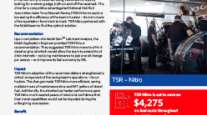Retail Diesel Fuel Average Price Rises 2.6¢ to $4.124 per Gallon
This story appears in the May 9 print edition of Transport Topics.
The average retail price of U.S. diesel resumed its upward march last week, climbing 2.6 cents per gallon to $4.124 and sparking renewed attention to fuel surcharge collections.
The U.S. Department of Energy’s May 2 report showed the 15th diesel price increase in 17 weeks of 2011. The rises have totaled 80.1 cents per gallon, while the two declines were a meager 0.8 cents, for a net increase of 79.3 cents so far this year. Diesel is up $1.002 — or 31% — in the past year while gasoline has climbed $1.065, or 37%.
Gasoline increased last week by 8.4 cents a gallon to a $3.963 national average.
Last week, after it hit a 32-month high of $113.93 a barrel April 29, crude oil slipped to around $110 as inventories rose.
Brent Holliday, CEO of Nebraska Transport Co., Scottsbluff, Neb., said his fleet is increasing surcharges to offset rising fuel prices. Nebraska Transport, primarily a less-than-truckload operator, runs 150 tractors in Nebraska and surrounding states.
“We have come to a point where we have to be very selective with regard to negotiation of fuel surcharges or caps [on surcharges],” Holliday told Transport Topics May 3. “We just can’t carry the [fuel-price increase] load any more.”
“For some [shippers], there is an unwillingness to be flexible” and pay more, he said. “If there is a situation where we can’t make a profit on a load, for fuel or another reason, we have to part company. That’s never a favorable situation. Fortunately, it is not a high percentage of our customers.”
Many customers are sophisticated and recognize the need for the increases because they fuel their own trucks and pay more for gasoline in their fleet vehicles or personal cars, Holliday said.
Another fleet executive agreed.
“We are really assessing the fuel surcharge and the rates,” said Stephanie “Sam” Fleetman, owner of Mustang Expediting Inc., Aston, Pa. “Some shippers may see a small rate increase if they won’t budge on the fuel.”
She said, “Shippers should really consider paying the fuel surcharge” if it is increased because base rates don’t change as often.
Concern is mounting because fuel prices have never been higher, other than between April and August 2008, when the diesel record of $4.764 was set, as was the gasoline record of $4.114.
Fuel prices and surcharges also affect brokers.
“Just like carriers and shippers, we are paying the price for the high cost of fuel,” said Alec Gizzi, president of JBS Logistics Inc., Glendale Heights, Ill., an asset-light broker.
“The fuel index can help you, but unlike the carrier that can keep a handle on its costs, a broker is vulnerable in this market,” with margins that are squeezed as diesel costs rise, Gizzi said. The surcharge “may not be enough to keep them profitable,” he said.
To move their freight, brokers rely on a combination of contract pricing with a base rate and fuel surcharge and spot-market transactions.
In contract pricing with a shipper, Gizzi said, fuel-price changes affect only the surcharge portion, which can hurt the broker when prices rise. The effect, however, is limited because the base rate doesn’t change.
But the spot market, Gizzi said, provides its own set of challenges. Prices are based on individual transactions and per-mile rates that include fuel costs for drivers as well as other factors, including supply-and-demand conditions in each freight lane.
“Fuel adds a complication,” he said, “because if you are a trucker getting the same base price per mile, you don’t want to run to areas where diesel is highest, such as California or the East Coast. You’re better off running to the Midwest or South, where diesel costs less when you have to refuel.”
That fact was illustrated in last week’s prices. Diesel was 20 cents cheaper in the South and Midwest than it was in the Northeast and 40 cents lower than in California.
One step that Mustang has taken to control costs is to advise drivers to compare fuel prices at roadside locations with the price the company is paying at its on-site fueling facility. Fleetman said the company also tells drivers to use direct routes and avoid longer routes that drive up fuel expense. Mustang’s fleet of 20 tractors serves Pennsylvania and nearby states with specialized services, moving and warehousing.
The fuel-price picture also includes an acceptance factor.
“We just have to deal with [high fuel prices], like in 2008,” Fleetman said. “It is not quite as bad as 2008, but it is getting there.”
Holliday made a similar point.
“We became pretty smart over the last 2½ years,” he said. “You had to be pretty efficient. Now that the economy is getting better, we find the fuel-price situation rearing its ugly head. That’s taken away some of the joy.”




